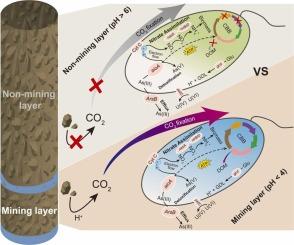Arsenite-oxidizing chemolithooautotrophic prokaryotes underpin inorganic carbon fixation and arsenic detoxification in deep underground uranium mining layers
IF 11.3
1区 环境科学与生态学
Q1 ENGINEERING, ENVIRONMENTAL
引用次数: 0
Abstract
Acid in-situ leach uranium (U) mining layers (ML) characterized by anaerobic, oligotrophic conditions, high arsenic (As) concentration, represent an unique but poorly characterized microbial habitat. Herein, autotrophic microbial metabolisms and arsenic detoxification strategies in underground ML (depth >111 m) were revealed through 16S rRNA gene amplicon sequencing and metagenomic analysis. Dissolved organic matter (DOM) content in ML after acid in-situ leach mining was significantly higher than that in non-mining layers (NML). Compared with NML, the arsenite (As(III)) content in ML showed a decreasing trend, while the As(V) content correspondingly increased significantly. As(III) and DOM showed significant positive effects on the diversity of bacterial communities in ML and NML. The genes involved in Calvin Benson Bassham (CBB) pathway and monosaccharide decomposition dominated the DOM dynamics in ML and NML. Notably, metabolic pathway analyses demonstrated that microbial As(III) anaerobic oxidation by coupling with nitrate reduction favors CO2 fixation driven by CBB pathway, reducing As toxicity and enhancing DOM content in ML. Chemolithoautotrophs utilize multiple survival strategies (e.g., nitrate assimilation, metals efflux) in ML. These findings reveal that chemolithoautotropic microbial As(III) oxidation contributes to CO2 fixation and As detoxification in ML, broadening our horizons of As and carbon cycling in deep underground mining environments.

亚砷酸氧化化石自养原核生物是地下铀矿深层无机碳固定和砷解毒的基础
酸性原地浸出铀(U)矿层(ML)具有厌氧、低营养条件、高砷(As)浓度的特点,是一种独特但特征不明显的微生物栖息地。通过16S rRNA基因扩增子测序和宏基因组分析,揭示了地下ML(深度>;111 m)自养微生物代谢和砷解毒策略。酸地浸采后表层土壤中溶解有机质(DOM)含量显著高于非表层土壤(NML)。与NML相比,ML中亚砷酸盐(As(III))含量呈下降趋势,而As(V)含量相应显著增加。As(III)和DOM对ML和NML细菌群落多样性有显著的正向影响。参与CBB途径和单糖分解的基因主导了ML和NML的DOM动态。值得注意的是,代谢途径分析表明,微生物As(III)厌氧氧化与硝酸盐还原耦合有利于CBB途径驱动的CO2固定,降低了ML中的As毒性并增加了DOM含量。趋化石自养生物在ML中利用多种生存策略(如硝酸盐同化,金属外排)。这些研究结果表明,趋化石自养微生物As(III)氧化有助于ML中的CO2固定和As解毒。拓宽了我们对深部地下开采环境中砷和碳循环的研究视野。
本文章由计算机程序翻译,如有差异,请以英文原文为准。
求助全文
约1分钟内获得全文
求助全文
来源期刊

Journal of Hazardous Materials
工程技术-工程:环境
CiteScore
25.40
自引率
5.90%
发文量
3059
审稿时长
58 days
期刊介绍:
The Journal of Hazardous Materials serves as a global platform for promoting cutting-edge research in the field of Environmental Science and Engineering. Our publication features a wide range of articles, including full-length research papers, review articles, and perspectives, with the aim of enhancing our understanding of the dangers and risks associated with various materials concerning public health and the environment. It is important to note that the term "environmental contaminants" refers specifically to substances that pose hazardous effects through contamination, while excluding those that do not have such impacts on the environment or human health. Moreover, we emphasize the distinction between wastes and hazardous materials in order to provide further clarity on the scope of the journal. We have a keen interest in exploring specific compounds and microbial agents that have adverse effects on the environment.
 求助内容:
求助内容: 应助结果提醒方式:
应助结果提醒方式:


